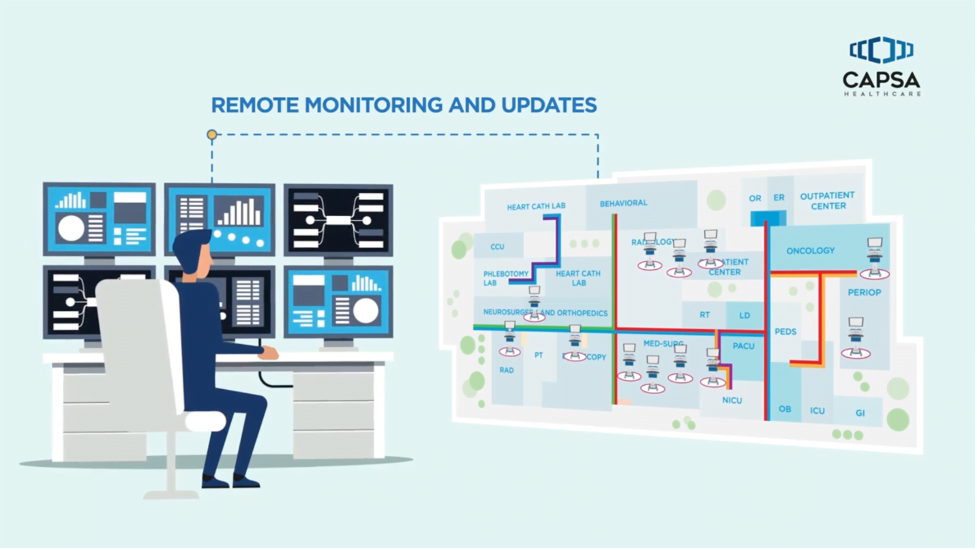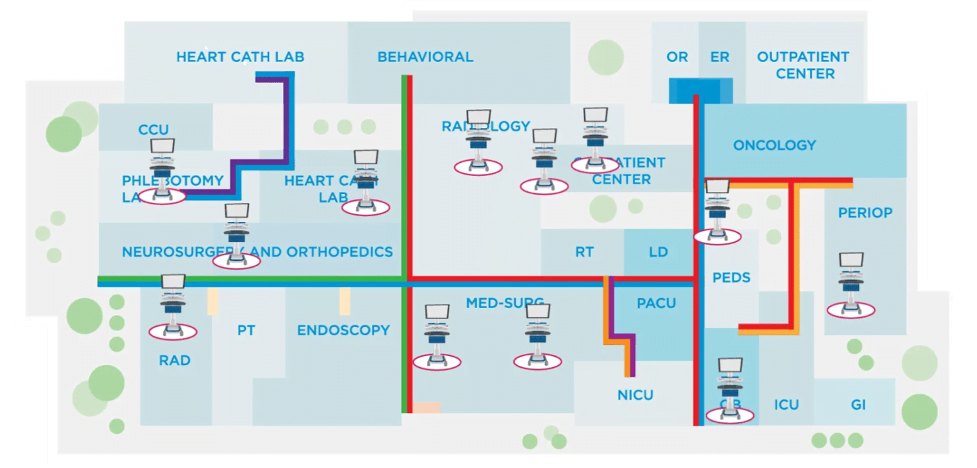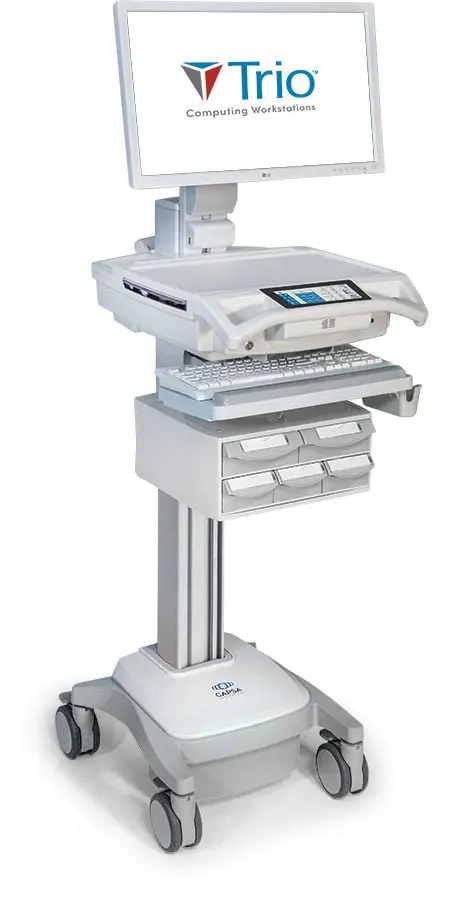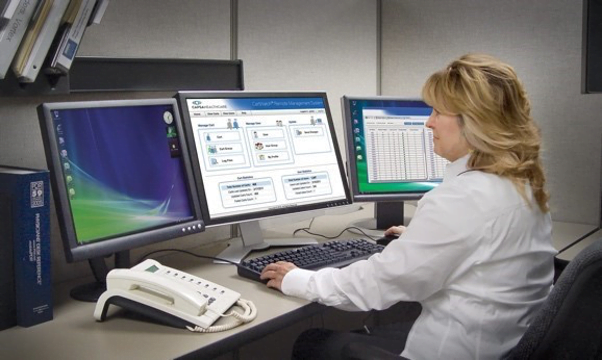
Medical equipment, carts, and devices are essential yet costly assets. In 2018, hospitals dedicated a staggering $200 billion to medical devices, representing approximately 6% of annual health expenditures. However, not every device is operational. Some linger in the wings, waiting for occasional use or standing by as backup for their malfunctioning counterparts, consigned to storage or sidelined.
The critical issue here is that the loss of any piece of equipment, no matter how infrequently used, carries substantial implications. It has the potential to strain resources and trigger a crisis if its operational counterpart unexpectedly fails. Without functioning equipment, healthcare workers struggle to provide optimal care to patients.
This is where fleet management comes into play. But what is fleet management exactly? It’s the process of tracking, maintaining, and optimizing devices and medical mobile carts within the hospital or healthcare system. Following a few core principles can enhance fleet performance and benefit your organization.

One of the core components of fleet management is maintaining an accurate inventory and status of all assets. The simplest version is an Excel sheet that lists each trolley, workstation, medical cart battery, hospital accessory, location, maintenance, and operating status. However, a basic system often isn’t practical with the volume of devices in most facilities.
Instead, modern, comprehensive cart tracking involves fleet management software to find and monitor carts remotely anywhere in the hospital or facility. The goal is to gain visibility into asset utilization and right-size your fleet for clinical demands. Plus, you can track connectivity, usage frequency, and power levels for increased device uptime, ensuring you have enough equipment in the right place at the right time.

Part of fleet management is maintaining equipment for optimal use in the facility. One of the better methods is to shift from reactive maintenance to a predictive and preventive plan.
Preventive maintenance proactively identifies potential issues before they impact cart performance, ensuring uninterrupted uptime and availability. By leveraging historical data, we can pinpoint carts that may benefit from scheduled maintenance to enhance their performance and prevent potential disruptions. This approach is less time-consuming and leads to less workflow interruption.
Additionally, using real-time monitoring, the fleet manager and team can analyze machine data and scan for abnormal activity that may cause device downtime. Predicting downtime and planning routine maintenance allows for lower maintenance costs and longer device lifespans.
Successful medical cart fleet management also allows teams to review the effect of a new device on the workflow and overall performance. Using fleet management technology, you can analyze staff interactions with the equipment, uptime on tasks, or areas of improvement.
For example, let’s say you set up staff as users on medication carts and track user activity, logins, and relocking. You can use data to investigate alert overrides and unsecured equipment, evaluate staff performance, or find ongoing issues. That data can inform new training programs or performance improvement plans to help reduce those problems or correctly onboard new staff.

When it comes to medical cart fleet management, outcomes such as cost savings, improved efficiency, and better safety compliance provide direct benefits to your facility, staff, and patients.

Hospitals often adopt medical carts for EHR documentation, storage, workflow optimization, and reduced operational costs. Medication carts, for example, streamline the dispensing process and help prevent medication errors, adverse events, and drug loss or theft.
However, without an adequate system for managing cart fleets, your equipment may end up misplaced, lost, or underused, costing your organization more money. Fleet management solutions help you track each asset and optimize resources, preventing underutilization.
Management and planned maintenance also help extend the lifespan of your equipment. You gain more use and value for your initial spend and lower operating costs.
Surveys show that nurses waste an hour every shift looking for equipment in unintegrated facilities. They spend another hour looking for equipment for other people, and about 16% eventually give up, never finding the equipment.
The same survey suggests that time spent searching for equipment equals roughly 40 hours each month, a costly example of operational inefficiency. Cart fleet management systems significantly improve device access and delivery, tracking your equipment across the entire hospital or facility.
With remote monitoring, you can quickly find a cart and ensure it gets where it needs to go immediately.
Using a fleet management system, hospital IT teams can efficiently and remotely handle tasks like managing user IDs, PIN codes, and user permissions right from their desktops, which saves time and boosts efficiency.
Moreover, many fleet management systems provide insights into power consumption and the ability to adjust technology settings. This helps extend cart runtimes and enhances operational efficiency.
Medical equipment breaks or wears down over time, leading to safety or compliance risks. A simple problem, such as a broken or worn wheel, may impact cart movement, leading to back strain and health and safety issues.
Fleet management involves ongoing monitoring and proactive maintenance, helping you find and fix problems before they become an issue. The result is improved safety and compliance in the workplace and fewer costly issues.
Technology has transformed the way hospitals care for patients. Chances are that your hospital or facility has some form of modern technology enabling remote connectivity and monitoring. Yet, while hospitals acquire more equipment and technology, many need help managing assets, operations, and cash flow.
In today’s economy of rising costs, staff shortages, and poor performance in key measures, it can no longer be business as usual. The sooner an organization leverages technology, the sooner it becomes more efficient and uses every dollar spent.

Technology for advanced fleet management is one solution to the staggering yet preventable costs of lost or underused medical equipment. A cloud-based software provides remote, real-time medical cart monitoring and management at the point of care. Track equipment for optimal asset utilization and identify and fix issues before they impact staff and clinicians.
Fleet management solutions allow you to remotely update software, PIN codes, and security settings, monitor cart charging and medical cart accessories, and locate lost carts, all from a central dashboard. You can troubleshoot and solve common issues, monitor user activity, and extend runtime with remote setting adjustments from your office. There’s no need to track down the device or staff member.
With advanced technology, you can streamline workflows. Data and analytics give you insight into your clinical needs and how your fleet meets those demands, giving you visibility into asset usage and ROI.
An efficient system produces better performance and output with fewer inputs or resources. Comprehensive fleet management helps you achieve efficiency and get more from your medical cart fleet while generating cost savings and better safety compliance, especially with the help of a fleet management company or technology.
Advanced software, such as N-Sight Fleet Management from Capsa Healthcare, provides the connectivity, monitoring, and data you need to deploy your devices efficiently. Learn how to transform your fleet for better asset utilization, remote management, and integration.